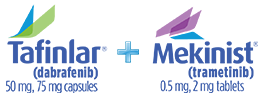
Safety Profile
Adverse Reactions
The safety of TAFINLAR + MEKINIST in pediatric patients aged 1 to <18 years with BRAF V600E mutation–positive low grade-glioma (LGG) was evaluated in the multicenter, open-label, phase 2 clinical trial G2201. The safety profile of TAFINLAR + MEKINIST in pediatric patients was consistent with the established safety profile, with no new safety signals identified.1-4
Adverse reactions (≥15%) in pediatric patients in the G2201 study1,2,a
TAFINLAR + MEKINIST (n=73) | Chemotherapy (n=33) | |||
| Adverse Reactions | All Grades (%) | Grade ≥3 (%) | All Grades (%) | Grade ≥3 (%) |
| Gastrointestinal | ||||
| Vomiting | 34 | 1 | 48 | 3 |
| Diarrheab | 29 | 0 | 18 | 6 |
| Nausea | 25 | 0 | 45 | 0 |
| Abdominal Painc | 25 | 0 | 24 | 0 |
| Constipation | 12 | 0 | 36 | 0 |
| Stomatitisd | 10 | 0 | 18 | 0 |
| General | ||||
| Pyrexiae | 68 | 8 | 18 | 3 |
| Fatiguef | 33 | 0 | 39 | 0 |
| Nervous System | ||||
| Headacheg | 47 | 1 | 33 | 3 |
| Dizzinessh | 15 | 0 | 9 | 3 |
| Peripheral Neuropathyi | 7 | 0 | 45 | 6 |
| Vascular Disorders | ||||
| Hemorrhagei | 25 | 0 | 12 | 0 |
| Skin | ||||
| Rashk | 51 | 2.7 | 18 | 3 |
| Dry Skin | 26 | 0 | 3 | 0 |
| Dermatitis Acneiforml | 22 | 0 | 0 | 0 |
| Alopecia | 3 | 0 | 24 | 0 |
| Musculoskeletal and Connective Tissue Disorders | ||||
| Musculoskeletal Painm | 34 | 0 | 30 | 0 |
| Pain in Jaw | 1.4 | 0 | 18 | 0 |
| Metabolism and Nutrition Disorders | ||||
| Decreased Appetite | 5 | 0 | 24 | 0 |
| Respiratory, Thoracic, and Mediastinal Disorders | ||||
| Oropharyngeal Pain | 11 | 0 | 18 | 0 |
| Psychiatric Disorders | ||||
| Anxiety | 1.4 | 0 | 15 | 3 |
| Immune System Disorders | ||||
| Hypersensitivity | 0 | 0 | 15 | 3 |
| Infections and Infestations | ||||
| Upper Respiratory Tract Infection | 15 | 0 | 6 | 0 |
| Injury, Poisoning, and Procedural Complications | ||||
| Infusion-Related Reaction | 0 | 0 | 15 | 3 |
| Investigations | ||||
| Weight Increased | 15 | 7 | 0 | 0 |
aNational Cancer Institute Common Terminology Criteria for Adverse Events version 4.03.
bIncludes diarrhea, colitis, enterocolitis, and enteritis.
cIncludes abdominal pain and upper abdominal pain.
dIncludes stomatitis, cheilitis, mouth ulceration, aphthous ulcer, and glossitis.
eIncludes pyrexia and body temperature increased.
fIncludes fatigue and asthenia.
gIncludes headache and migraine with aura.
hIncludes dizziness and vertigo.
iIncludes peripheral neuropathy, peripheral motor neuropathy, peripheral sensorimotor neuropathy, paresthesia, neuralgia, hypoaesthesia, and peripheral sensory neuropathy.
jIncludes epistaxis, postprocedural hemorrhage, hematuria, upper gastrointestinal hemorrhage, and hemorrhage intracranial.
kIncludes rash, rash macular, rash maculo-papular, rash pustular, rash papular, rash erythematous, eczema, erythema multiforme, dermatitis, dermatitis exfoliative, skin exfoliation, palmar-plantar erythrodysesthesia syndrome, and dermatitis bullous.
lIncludes dermatitis acneiform, acne, and acne pustular.
mIncludes back pain, myalgia, pain in extremity, arthralgia, bone pain, non-cardiac chest pain, neck pain, and musculoskeletal stiffness.
Incidence of Serious Adverse Reactions and Treatment Discontinuation
Serious treatment-related adverse reactions5
aVincristine and carboplatin.
Permanent treatment discontinuation due to adverse reactions5
aVincristine and carboplatin.
Treatment-related adverse reactions (ARs) occurred in 93.2% (n=68) of patients in the TAFINLAR + MEKINIST group vs 97% (n=32) in the chemotherapy group5
ARs leading to dose adjustment or interruption occurred in 84% (n=61) of patients in the TAFINLAR + MEKINIST group (45% [n=33] grade ≥3) vs 79% (n=26) in the chemotherapy group (58% [n=19] grade ≥3)5
The overall management of certain ARs may require treatment interruption, dose reduction, or treatment discontinuation, depending on severity1,2


